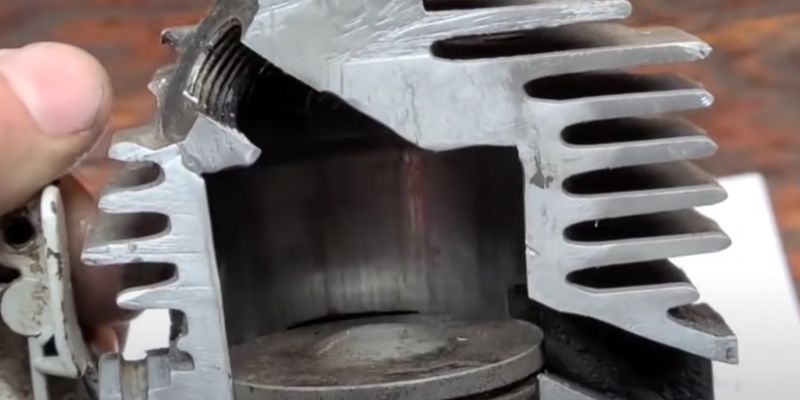To port a chainsaw, you need to remove the cylinder head and replace it with a larger one. This process requires careful disassembly and reassembly of the chainsaw components.
Understanding Chainsaw Porting
Understanding chainsaw porting requires a deep understanding of how to optimize airflow and performance. Learn the process of porting a chainsaw for enhanced power and efficiency.
Chainsaw porting is a technique that can significantly enhance the performance of your chainsaw, allowing it to cut through wood like a hot knife through butter. In this section, we will explore the ins and outs of chainsaw porting, including what it is and the various types available to you.
What Is Chainsaw Porting?
Chainsaw porting is the process of modifying the intake and exhaust ports on a chainsaw’s cylinder. By making precise changes to these ports, airflow can be optimized, leading to improvements in power, torque, and overall performance. It involves reshaping and enlarging the ports, allowing for increased fuel and air mixture flow, resulting in better combustion and more efficient power transfer to the chain.

Types Of Chainsaw Porting
There are several types of chainsaw porting techniques that you can employ, depending on your specific needs and desired outcome. Let’s take a closer look at each one:
1. Stock porting: This is the simplest form of chainsaw porting and involves minor modifications to the stock configuration. It typically includes slight enlargements and reshaping of the ports, aiming to enhance performance without compromising reliability or longevity.
2. Competition porting: As the name suggests, this type of porting is geared towards competitive chainsaw use. It involves more extensive modifications, such as enlarging ports, removing material, altering timing, and optimizing compression. Competition porting is intended for those who prioritize maximum power and performance over longevity.
3. Mild performance porting: This type of porting strikes a balance between stock and competition porting. It includes moderate modifications to the ports, resulting in improved performance without sacrificing too much in terms of reliability or durability. Mild performance porting is a popular option for those seeking a noticeable boost in power for general purpose cutting tasks.
4. Wild performance porting: For the most adventurous chainsaw enthusiasts, wild performance porting represents the ultimate in power and cutting performance. This type of porting involves extensive modifications, including significant enlargements of the ports, reshaping, and other alterations that push the chainsaw to its absolute limits. Wild performance porting should only be attempted by experienced individuals who are willing to accept the trade-offs in terms of reliability and longevity.
No matter which type of chainsaw porting you choose, it is crucial to ensure that the modifications are carried out by a skilled and knowledgeable professional. Proper porting requires precision and expertise to achieve the desired results and prevent any unintended negative consequences.
Now that you have a better understanding of chainsaw porting and the different types available, you can make an informed decision on how to optimize the performance of your chainsaw for your specific needs. Whether you’re a professional logger or a weekend warrior tackling your DIY projects, chainsaw porting can unlock a whole new level of cutting power and efficiency.
Step-by-step Guide To Porting A Chainsaw
Porting a chainsaw can significantly enhance its performance, allowing it to operate at optimized power levels. Whether you’re a professional lumberjack or an enthusiastic DIYer, porting your chainsaw can help you cut through wood with greater ease and efficiency. In this step-by-step guide, we will walk you through the process of porting a chainsaw, starting from gathering the necessary tools and materials, to preparing the chainsaw for porting, and finally, performing the porting process.
Gathering The Necessary Tools And Materials
Before you begin porting your chainsaw, it is essential to gather all the necessary tools and materials. Having everything you need ready will help streamline the porting process and minimize interruptions. Here is a list of tools and materials you will need:
| Tools | Materials |
|---|---|
|
|
Preparing The Chainsaw For Porting
Once you have gathered all the necessary tools and materials, it’s time to prepare the chainsaw for porting. Follow these steps to ensure your chainsaw is ready:
- Start by disconnecting the spark plug wire to prevent accidental starting.
- Clean the chainsaw thoroughly using a cloth and carburetor cleaner to remove any dirt or debris that may be present.
- Inspect the chainsaw’s chain and bar for any signs of wear or damage. Replace if necessary.
- Empty the fuel tank and refill it with a fresh gasoline-oil mixture, following the manufacturer’s recommendations.
- Inspect the air filter and replace it if excessively dirty or damaged.
- Secure the chainsaw on a workbench or a sturdy surface, ensuring it is stable and won’t move during the porting process.
Performing The Porting Process
Now that your chainsaw is prepared for porting, it’s time to start the actual process. Here’s a step-by-step breakdown of how to perform the porting:
- Identify the intake, exhaust, and transfer ports on the chainsaw’s cylinder. Use porting templates to ensure accuracy.
- Using a drill, carefully remove any rough edges or uneven surfaces from the ports. Be cautious not to remove too much material, as this can negatively impact the chainsaw’s performance.
- Smooth the ports using files and sandpaper, making sure they are free from any irregularities or obstructions.
- Reassemble the chainsaw, ensuring all parts are properly tightened.
- Apply lubricant to the chainsaw’s components to prevent friction.
- Start the chainsaw and allow it to run for a few minutes to ensure everything is functioning correctly.
- Adjust the carburetor settings if necessary for optimal performance.
Following these steps will guide you through the process of porting a chainsaw. Remember to exercise caution and prioritize safety throughout the entire process. When performed correctly, porting can enhance your chainsaw’s power and efficiency, making your cutting tasks easier and more enjoyable.
Tips And Tricks For Maximum Power
When it comes to porting a chainsaw, there are several tips and tricks that can help you achieve maximum power. From optimizing the fuel and air mixture to choosing the right bar and chain, these techniques can make all the difference in your chainsaw’s performance. In this article, we will delve into these aspects in detail and provide you with valuable insights to enhance your chainsaw’s power.
Optimizing Fuel And Air Mixture
One of the most critical factors in maximizing power is optimizing the fuel and air mixture in your ported chainsaw. The ideal fuel mixture for most chainsaws is a ratio of 1:50, which means one part two-stroke oil mixed with 50 parts gasoline. This ratio ensures proper lubrication and prevents engine damage. However, it is essential to consult your chainsaw’s user manual to determine the recommended fuel mixture for your specific model.
Additionally, it’s crucial to check the air filter regularly and clean or replace it as needed. A clogged air filter can restrict airflow to the engine, resulting in decreased power output. By ensuring a clean air filter, you can optimize the air-fuel ratio and enhance your chainsaw’s performance.
Choosing The Right Bar And Chain
The bar and chain play a vital role in the overall performance of your ported chainsaw. Consider the length, gauge, and pitch of the bar to ensure compatibility with your chainsaw’s engine power and your cutting requirements. A longer bar allows for larger cuts, while a shorter bar provides more maneuverability in tight spaces. Assess your needs and select the appropriate bar length accordingly.
Additionally, pay attention to the chain’s design and tooth configuration. Chains with larger teeth are ideal for cutting through tough and dense wood, while smaller teeth provide smoother cuts. Choose a chain that suits your cutting needs to maximize your chainsaw’s power.
Maintaining The Ported Chainsaw
Proper maintenance is vital to keep your ported chainsaw functioning at its peak performance. Regularly inspect the spark plug and clean or replace it if necessary. A clean spark plug ensures efficient combustion and optimal power output. Additionally, keep an eye on the chain tension and adjust it as needed. A loose chain can reduce cutting efficiency and performance.
Furthermore, don’t forget to lubricate the bar and chain to reduce friction and increase cutting speed. Refer to your chainsaw’s manual for the recommended lubricant and ensure frequent and adequate lubrication.
Summary
To achieve maximum power with your ported chainsaw, it is crucial to optimize the fuel and air mixture, choose the right bar and chain, and maintain the chainsaw regularly. By following these tips and tricks, you can enhance your chainsaw’s performance and tackle even the most demanding cutting tasks with ease.
Safety Precautions
When it comes to porting a chainsaw, taking safety precautions is of utmost importance. By following these safety guidelines, you can ensure a safe and successful porting process. Let’s take a closer look at some essential safety measures:
Wearing Proper Protective Gear
Before you even think about starting the porting process, it is crucial to equip yourself with the right protective gear. This will not only protect you from potential injuries but also minimize the risks involved. Make sure to wear:
- A safety helmet with a face shield or safety goggles to shield your eyes and face from debris.
- Durable work gloves that offer a good grip and protect your hands from harm.
- Ear protection, such as earmuffs or earplugs, to prevent hearing damage caused by the loud noise of the chainsaw.
- A sturdy pair of steel-toed boots that provide ankle support and protect your feet from falling objects.
Avoiding Common Porting Mistakes
Porting a chainsaw requires precision and attention to detail. To ensure a successful porting process, here are some common mistakes you should avoid:
- Skipping the planning stage: Take the time to plan your porting project carefully. Analyze your needs and research different porting techniques before getting started.
- Ignoring safety guidelines: Always refer to the manufacturer’s manual while porting your chainsaw and adhere to their guidelines. Disregarding safety precautions can lead to serious accidents and injuries.
- Overdoing the porting: It’s essential to maintain a balance when porting your chainsaw. Over-ambitious porting can result in reduced reliability and even engine damage. Follow the recommended porting specifications to achieve optimal performance.

Understanding The Risks Involved
Porting a chainsaw involves certain risks that you must be aware of. By understanding these risks, you can take necessary precautions and make informed decisions throughout the process. Some risks associated with chainsaw porting include:
- Increased engine temperatures: Porting can lead to increased heat buildup inside the chainsaw engine, which may impact its durability and performance. Ensure proper cooling and consider modifications to manage temperatures.
- Reduced engine lifespan: Incorrect porting techniques or excessive modification may decrease the overall lifespan of the chainsaw engine. It’s crucial to strike the right balance between performance and longevity.
- Personal injury: Operating a chainsaw without proper precautions can result in severe injuries. Always prioritize safety and take necessary steps to protect yourself.
By keeping these risks in mind, you can approach the porting process with caution and minimize any potential issues.
Frequently Asked Questions For How Do You Port A Chainsaw
What Does It Mean If A Chainsaw Is Ported?
A ported chainsaw has modified intake and exhaust ports to increase power and performance. It allows better airflow, leading to greater fuel combustion and improved efficiency. Porting helps the chainsaw cut faster and handle tougher tasks with ease.
What Is Woods Porting A Chainsaw?
Woods porting a chainsaw is the process of modifying the intake and exhaust ports in the cylinder to increase engine performance. It improves airflow for better power and speed.
How Do You Crank A Chainsaw?
To crank a chainsaw, follow these steps: 1. Ensure the saw is on a stable surface. 2. Engage the chain brake. 3. Set the choke to “on” and prime the engine. 4. Pull the starter cord until you feel resistance, then give a firm, quick pull.
5. Disengage the choke and rev the engine.
How Does A Chainsaw Muffler Work?
A chainsaw muffler works by reducing the noise produced during operation. It does this by redirecting and expanding the exhaust gases, which helps to dampen the sound. The muffler contains baffles or chambers that restrict the flow of exhaust gases, reducing the noise level.
Conclusion
Porting a chainsaw requires careful consideration of several factors: the type and size of the chainsaw, the specific modifications desired, and the expertise of the individual performing the porting. It is crucial to follow safety guidelines and seek professional help if necessary.
By understanding the process and its implications, individuals can enhance the performance and efficiency of their chainsaws while ensuring their own safety.


